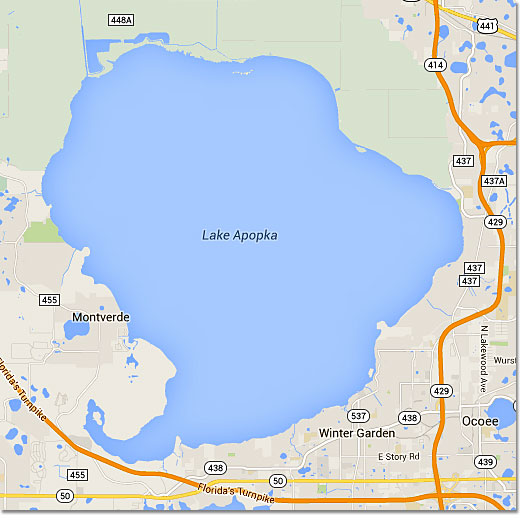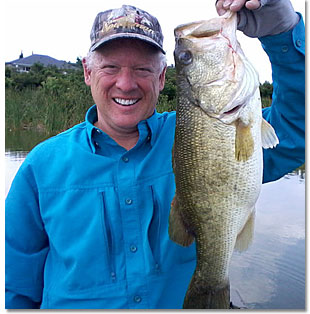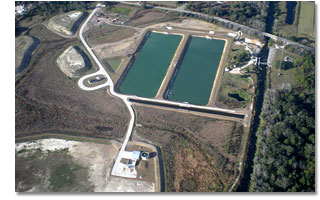|
Fishing Lake Apopka
Lake Apopka, located just north of Orlando, covers over 30,000 acres and is one of the largest bodies of fresh water in Florida. Lake Apopka is very shallow with little lakefront development. Lake Apopka also has a large population of alligators, making swimming a somewhat risky and certainly nervous endeavor. More...
Back in the forties and fifties it was said that the lake was so clear you could sight fish bass. It's been abused for so long that today it's not much more than a swamp. Heavily polluted by agricultural back pumping and sewage runoff, this lake has begun a slow road to recovery. Lake Apopka will most likely never be a clear white sand bottom water ski lake. Dredging the whole lake down to the aquifer might make this happen, but the expense would be enormous. However, the closing and flooding of the farms around the lake plus the tightening of discharge regulations has helped to change the downward course of this once great bass fishing lake. Significant efforts are underway in an attempt to improve the water quality. Over 20 million pounds of shad and 20 million metric tons of phosphorus have been removed from the lake. What the lake needs most is more water. The Winter Garden boat ramp is currently unusable for large bass boats due to low water levels. High speed running in the lake is ill-advised due to submerged tree stumps and large alligators.
At this time, the main lake water is still very turbid except for the area around Gourd Neck Springs. This huge spring pumps clear water into the lake and the demarcation line can be clearly seen from a boat. The water visibility in the rest of lake is less than a foot and most people would immediately be repulsed by the look of the water. This is OK with me as the lake has become somewhat of a secret fishing hole for a small number of tournament anglers who make the long Sunday run.
We recently began making trips to Lake Apopka to check out these reports. Our first scouting trip to the lake produced two limits of fish up to 6 pounds in a period of about 3 hours. The fish were very healthily and were strong fighters. The water color is terrible at best and the lake isn't the prettiest to look at, but the bass fishing is worth the effort. We are encouraged by what we've seen so far and are planning to fish the lake seriously in the coming years.
NOTE: Large alligators and stumps away from shore make running in Lake Apopka at speed hazardous. The shallow flats surrounding the lake contain deep mud and silt causing your water intake to clog. This lake is mostly deserted and if you break down, you could become stranded for an extended period of time. It is definitely not a good place for a Club Bass Tournament! We will be updating this page in the future as we have a better chance to evaluate this growing fishery.
Lake Apopka's Problems and Its Effects on the Harris Chain
The lake's problems actually started in the forties. During World War II to aid in the war effort, numerous vegetable farms began operating in the fertile muck lands surrounding Lake Apopka. In those days, normal operating procedure was to flood the fields and back pump the runoff. This annual back pumping injected millions of pounds of fertilizer, pesticides and hazardous chemicals into the lake. In addition, millions of gallons of raw sewage and storm drain runoff was regularly pumped into Lake Apopka from the nearby city of Winter Garden. This culminated in a total collapse of the lake's ecosystem in the early sixties. Lake Apopka, one of the most polluted bodies of water in the South, sits in the shadow of the famous Orlando Theme Parks. It's incredible to me that State and Federal Governments are willing to spend billions of dollars restoring the Everglades and left this lake in the condition it's in. If you want to know more about this issue visit
In 1997 after years of negotiations, the State of Florida agreed to buy out the remaining muck farms and begin the process of restoring the lake. Early in the process, the farm land surrounding the lake was flooded in an attempt to restore the shoreline. This attracted water birds who fed in the flooded fields and began dying in alarming numbers. The flooded fields also caused millions of mice to abandon their nests and quickly began invading nearby homes. Fortunately, these problems were short-lived and while Lake Apopka is still significantly polluted, it has seen some improvement in water quality. Numerous debates are underway to determine the best way to clean up this lake. Some are suggesting letting hydrilla take hold in the lake. There is no doubt that this solution will produce clearer water, but at what long term environmental and monetary cost? The only real long-term solution is to dredge the lake bottom and remove the contaminated soil. Given the huge size of Lake Apopka, the cost of dredging the lake is formidable. This cost coupled with the current economic downturn and lack of public funding is slowing the restoration of Lake Apopka. The fishing is starting to return and we think the lake has turned a corner. In 50 years or so, it may be a lake everyone can enjoy.
If you have any questions or comments about the Harris Chain or any Lake County Florida waterway, please contact us.
|




 Most anglers would be shocked to find that the Apopka bass population has rebounded at all. Slight improvement in habitat has
restored some underwater weed growth and the recent stocking of largemouth bass shows promise. Recent shocking surveys done by
the Florida Fish and Wildlife Commission show fishable populations of bass all along the 10 mile stretch from the Winter Park boat ramp
to the spring. Even better, low fishing pressure coupled with a large shad population is producing an outstanding size average. In
my opinion, the lake is very likely the home of some of the largest bass in Florida. It's entirely possible that the lake holds a world
record sized bass. This is not a fish story. The famous 17 pound bass pictured on antique boxes of Heddon Lures was caught in Lake
Apopka and the Wildlife Commission has reportedly shocked and tagged a number of real giants.
Most anglers would be shocked to find that the Apopka bass population has rebounded at all. Slight improvement in habitat has
restored some underwater weed growth and the recent stocking of largemouth bass shows promise. Recent shocking surveys done by
the Florida Fish and Wildlife Commission show fishable populations of bass all along the 10 mile stretch from the Winter Park boat ramp
to the spring. Even better, low fishing pressure coupled with a large shad population is producing an outstanding size average. In
my opinion, the lake is very likely the home of some of the largest bass in Florida. It's entirely possible that the lake holds a world
record sized bass. This is not a fish story. The famous 17 pound bass pictured on antique boxes of Heddon Lures was caught in Lake
Apopka and the Wildlife Commission has reportedly shocked and tagged a number of real giants. The Lake County Water Authority’s Nutrient Reduction Facility (NuRF) is a crucial step toward eliminating the majority of algae-feeding compounds exported from
Lake Apopka. After five years in development, the project is the largest alum-based surface water restoration facility ever built. In
total, the project cost $7.272 million to construct and approximately $1 million per year to operate. The facility is
located at the junction of Lake Beauclair and the Apopka/Beauclair canals. Though it’s hard to tell amidst the wildly fluctuating
weather patterns of the past ten years, the effects of the facility are starting to show some signs of improvement. Scientists have
observed a significant reduction of key phosphorus-containing compounds which are a primary food source for algae. The St. Johns
River Water Management District’s ongoing restoration of the muck farms surrounding Lake Apopka has been an important part of this
reduction.
The Lake County Water Authority’s Nutrient Reduction Facility (NuRF) is a crucial step toward eliminating the majority of algae-feeding compounds exported from
Lake Apopka. After five years in development, the project is the largest alum-based surface water restoration facility ever built. In
total, the project cost $7.272 million to construct and approximately $1 million per year to operate. The facility is
located at the junction of Lake Beauclair and the Apopka/Beauclair canals. Though it’s hard to tell amidst the wildly fluctuating
weather patterns of the past ten years, the effects of the facility are starting to show some signs of improvement. Scientists have
observed a significant reduction of key phosphorus-containing compounds which are a primary food source for algae. The St. Johns
River Water Management District’s ongoing restoration of the muck farms surrounding Lake Apopka has been an important part of this
reduction.